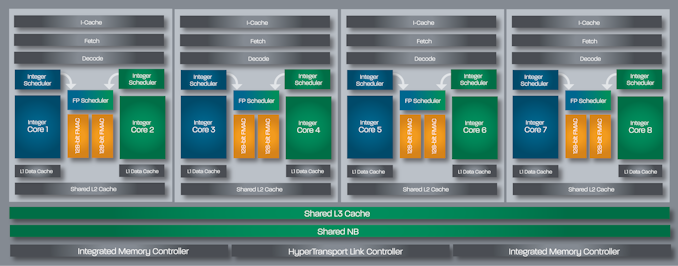AMD Bulldozer 'Core' Lawsuit: AMD Settles for $12.1m, Payouts for Some
by Anton Shilov on August 28, 2019 1:15 PM EST
AMD this month has agreed to pay compensation that totals $12.1 million to users who purchased FX-8000/9000 CPUs via its website or in the state of California. The case comes down to AMD advertising these processors as having 8 cores, and the claim that a shared FPU unit within a 'dual core' module does not constitute an actual core of performance similar to a separate core/FPU unit. Users who qualify for the compensation are estimated to recieve in the region on $35, depending on the exact uptake, and no one person can claim more than $7500.
AMD’s Bulldozer microarchitecture used 'dual-core modules' containing two independent ALUs and a shared FPU. AMD believed that such design allowed it to call its FX-8000 and FX-9000 series processors as the industry’s first eight-core desktop CPUs, yet the latter were quite often behind their quad-core rivals from Intel in terms of performance. As a result, a group of people from California filed a class action suit that accused AMD of false advertising back in 2015.
In early 2019, the Northern District Court of California sided with the plaintiffs and ruled that AMD’s FX-8120, FX-8150, FX-8320, FX-8350, FX-8370, FX-9370, and FX-9590 processors were incorrectly advertised as having eight cores. On August 23, the court published the class action settlement agreement under which AMD agreed to pay plaintiffs and the settlement class a compensation.
Under the terms of the deal, AMD has to create a $12.1 million settlement fund that will cover compensations to the end users, attorney fees, and settlement administration fees. The Class Counsel agreed to limit its petition for attorneys’ fees and reimbursement of expenses to no more than 30% of the fund, or $3.630 million, whereas the costs of settlement administration will be between $350,000 and $700,000. As a result, the pot to share between the actual purchasers of AMD’s select FX processors will be between $7.77 million and $8.12 million.
Purchasers entitled for up to $7500 total, have a confirmed purchase(s), and to have purched one of the processors while living in California or from AMD's website. It is noteworthy that people who bought AMD’s FX-8000E series CPUs with reduced power consumption are not eligible to get a reimbursement, and neither are people who purchased AMD’s six-core and quad-core FX-6000 and FX-4000 products.
It is hard to estimate how much money will each owner of AMD’s FX-8120, FX-8150, FX-8320, FX-8350, FX-8370, FX-9370, and FX-9590 processors will get, but considering the fact the settlement is limited to select CPUs and residents of California and those from AMD.com, actual sums may be quite sizeable. Should the actual value per unit be over $300, this will be subject to court approval.
AMD and the Settlement Administrator are order to crease a website at www.AMDCPUSettlement.com that should include the ability to file claim forms online. At press time, the website was offline, but it should be up shortly. We are awaiting AMD's official press release on the matter.
Update:
AMD has given an official comment on the result:
"AMD is pleased to have reached a settlement of this lawsuit. While we believe the allegations are without merit, we also believe that eliminating the distraction and settling the litigation is in our best interest."
Related Reading
- AMD's Steamroller Detailed: 3rd Generation Bulldozer Core
- The Bulldozer Review: AMD FX-8150 Tested
- The Bulldozer Aftermath: Delving Even Deeper
Sources: PACER, The Register (click through for document filing)











81 Comments
View All Comments
RedGreenBlue - Monday, September 2, 2019 - link
The bulldozer cores had FPUs. It is no less accurate to say that each core had a 128 bit FPU than it is to say they shared a 256 bit FPU. The only thing you could argue over is whether the scheduler had the capability for two FPUs, and if I’m not mistaken, AMD increased the FP scheduler’s entry capacity at least once. The goal of the architecture was to avoid one core’s FP being bombarded, while the abilities of another core were idle. The problem comes when the FP scheduler, or front-end, can’t keep up. They were constrained by TDP on the 32nm process such that they had to make sacrifices on those. Sacrifices they later found ways to improve. Some of it was also due to the block designing of the architecture, which was not efficient for layout or power efficiency, basically a build-to-order design rather than hand-crafted. I think Anandtech has multiple articles pointing out the issues and changes, but it caused a regression in IPC and an increase in pipeline length.The last editions of the bulldozer family made huge strides year after year in IPC, gains we would be happy to get with future versions of Zen.
Kvaern1 - Wednesday, August 28, 2019 - link
There are plenty of examples of much worse core advertising. My TV was advertised as having 6 cores...I believe 4 of them are CPU cores, the 5th is the GPU and the 6th I have no idea what is.lmcd - Wednesday, August 28, 2019 - link
GPU is probably separate from a VPU with codec accelerationpatel21 - Thursday, August 29, 2019 - link
Now that I read you, I remember Google also advertising its first Moto X something similar:The device is powered by a chipset branded as the X8 Mobile Computing System, which consists of a dual-core, 1.7 GHz Qualcomm Snapdragon S4 Pro system-on-chip with a quad-core Adreno 320 GPU, a custom-designed Natural Language Processor core and Contextual Awareness Processor core (for a total of 8 cores),
eek2121 - Thursday, August 29, 2019 - link
What TV? I've never seen a company advertising a TV, period.Kvaern1 - Thursday, August 29, 2019 - link
eek I'm not sure what you mean but when the official company webpage says the TV has a hexacore processor then it's advertised as having 6 cores. It doesn't literally have to be in a commercial or add they mention it.It's a Philips TV.
Lord of the Bored - Wednesday, August 28, 2019 - link
It does. Eight processor cores, and four math coprocessors.Cakemaster - Friday, August 30, 2019 - link
What on earth do you mean by expecting "8 cores to mean 8 identical cores", are you implying that the problem with these CPUs is that the cores weren't identical to each other? These CPUs did have the number of cores which they were advertised as having, they were just very mediocre CPUs overall. They were charging significantly less PER CORE than Intel was, and these CPUs were actually very reasonably priced.Furthermore, they actually do run quite well on software which is well optimized for them, and they have actually aged very well, as 8-core FX CPUs have closed a ton of ground vs. Intel CPUs from the same time period. AMD never claimed that each core was equivalent to the cores in other CPUs. Everybody knew back then that most software wasn't even well optimized for 4-core CPUs, and also that you should never make assumptions about the numbers in the product name or the spec sheet. The bottom line is always how well they actually peform according to quantifiable test data. Not even stupidity would explain why someone would have bought an FX CPU based on the assumption that more cores will always translate to higher performance, or that that the cores were equal to the performance of Intel CPUs which cost WAY MORE per core. It's not just a lie that these didn't have 8 cores, the idea that people were being mislead into buying these because they thought that they would perform better than Intel chips is also a lie.
Toe - Wednesday, August 28, 2019 - link
Let's put it this way: nobody would refer to a 486SX - which didn't have an FPU - as a 'zero core processor'.eek2121 - Thursday, August 29, 2019 - link
Thanks, yeah, while AMD was a bit sketchy here, If I were the judge, you couldn't have sold me this argument with a golden 10 foot pole. What makes it even more hilarious is that AMD and Cyrix both had much better CPUs at the time. We didn't see Intel getting sued.